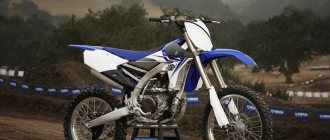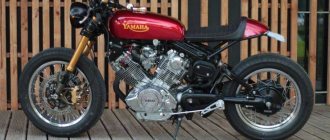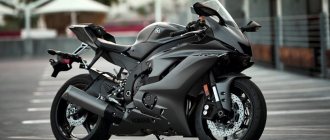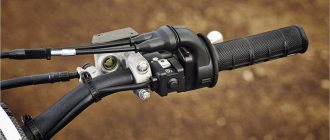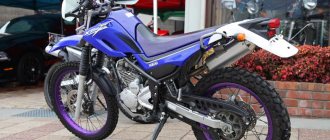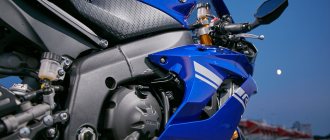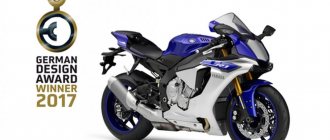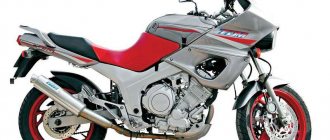The Yamaha YZF R3 model, sales of which started in 2015, became the concern's response to the Kawasaki Ninja 300 motorcycle, which appeared on the market a couple of years earlier.
The budget price, small engine volume, which, nevertheless, is more powerful than that of its competitor, played a role in the popularity of the model.
At the same time, managers especially emphasize that when creating the motorcycle, developments were used that were previously used only on top versions.
Specifications
The main difference from Kawasaki was the slightly larger engine, which had a positive effect on all parameters of the bike. This is a standard 4-stroke engine with 2 in-line cylinders.
The engine provides good dynamics at low and medium speeds, as well as good potential at high speeds.
- Working volume - 321 cm3.
- Power - 42 hp
- Number of valves - 8 (4 per cylinder).
- Cooling is liquid.
- Fuel supply - injector.
- Ignition is electronic.
- Start - electric starter.
- Tank volume - 14 l (including 3 l reserve).
Transmission and clutch
The main drive is a classic chain.
The only nod to modern bikes was the 6-speed gearbox.
Users noted that the gear ratios are selected so that you can drive around the city in first gear. The five others are only for “rocket guys”, which is probably why they are shifted to the very end of the rev range.
- Clutch - multi-disc , oil bath, power transmission - cable .
- The main drive is a chain .
Brakes
Front brakes.
Rear brakes.
Although one would expect drums to be installed on a budget bike, the brakes are nevertheless modern. Hydraulic disc rotors
Front brakes
- Number of disks - 2.
- Diameter - 298 mm.
- Support - 2-piston.
Rear brakes
- Number of disks - 1.
- Diameter - 220 mm.
- Support - 1-piston.
ABS is installed as standard. Such models are labeled YZF-R3A . In American markets you can see the YZF-R3. They are produced to order from American dealers and do not have ABS.
Yamaha YZF R3 test
Enough about the hardware. Let's go for a ride.
Our small column started in the city. Driving from traffic light to traffic light does not present any problems, due to the short first gear, which will appeal to beginners. The seat height is 78 cm, some may find it high, but the old model had lowering kits, the same can be expected on the 2019 model
The Yamaha YZF R3's pilot position is closer to sports. Controls are easily accessible. The updated display is high-contrast and legible – the selected gear and speed are visible at a glance. The tachometer, located at the top edge of the display, is sometimes difficult to read, but you don’t have to look at it, the engine itself will tell you what it wants.
And here we are on a country road. On the Yamaha R3, I calmly wedged myself into the general flow and it didn’t bother me; this was facilitated, among other things, by the mirrors with good visibility and slight dimming. Yamaha expected R3 owners to drive it to work, but many would prefer the highway. Although someone may have work a hundred kilometers away, this is not a problem for the R3.
At first it seemed that a sporty landing, lying on the tank, would not be very fun, but it turned out that this was not the case; on the contrary, such a landing hides you more under the glass.
At one of the corners I finally figured out a quirk of the bike that had been bothering me for most of the ride. I shifted from fourth to fifth gear and stepped on the gas, but the bike didn't accelerate much, I was expecting more traction. Then I remembered one detail from the presentation: the R3 has two overdrive gears! What a missed marketing opportunity. We could call them “overdrive” and “hyperdrive”. In any case, the motorcycle's maximum speed is achieved in fourth gear, with fifth and sixth being needed to maintain high speeds at lower revs. That's why they are called "overdrives". Novice pilots may not even know that their motorcycle has such gears, and usually there is only one. "Overdrives" are practical and make long trips less tiring and save you from noise at high speeds. Once I figured that out, second, third and fourth gears became my best friends when traveling in the R3. And Yamaha says they use these gears on their Star Venture and Star Eluder touring bikes.
Yamaha YZF-R3 2019
Now let’s refuel and head to the mountains.
Dust, fog and cold forced us to stop at a cafe and while we were waiting for our order, the guys from Yamaha showed us an unofficial function hidden in the motorcycle: glove warmers! The vents in the fairings are perfect for storing gloves and keeping them warm from the engine while you dine.
I appreciated the new suspension around town and on the highway, but it was on twisty, tight sections that it really came into its own. A small sports motorcycle simply has to handle well, and on the Yamaha YZF R3 you will love the grip on serpentine roads. It doesn't wobble in corners or bite under braking, unlike the 250s of yore, which seemed to have ballpoint pen springs in the suspension. But the rear suspension seemed a little soft, but a couple of clicks of spring preload will solve this problem. For reference, I weigh 80 kg.
The bike accelerates smoothly and the power delivery is very linear. The brakes are not super grippy, but respond to the slightest finger movement. If you like to spend long periods of time on race tracks, then it's worth considering better brake pads and reinforced hoses. My test bike was equipped with ABS, which only kicked in once when the wheels got caught in mud on the side of the road. I would recommend this option, since it is inexpensive.
Yamaha YZF-R3 2019
The 2022 R3 comes in three colors: Team Yamaha Blue, Matte Black and Bright White. White is a tragically underrated color in motorcycles. Blue is classic Yamaha. But the black one, I think, will be a hit.
And so we returned home with the Yamaha YZF R3. During the entire trip, the seat never reminded me of itself, which is amazing. It was also impressive that for the whole day on the highway and mountains there was still half a tank of fuel left. The Yamaha YZF R3 is not the biggest or the fastest, even among its classmates, but it will give you a lot of positive emotions. A day spent on the R3 proves that he is ready for any challenge. This motorcycle can be your first step into motorsports or just add to your experience.
Yamaha YZF-R3 2019
Driving performance
The maximum speed indicated in the documents is 175 km/h . Users who managed to “touch” the new model claim that this is an advertisement.
175 km/h from a hill and with a tailwind. In other conditions the motor will not pull.
Acceleration to hundreds
Acceleration from zero to 100 km/h is also not impressive - 6.5 seconds .
Fuel consumption
If you do not keep the tachometer needle in the red zone, it seems as if the motorcycle is not consuming fuel at all.
Fuel consumption with an average cruiser and a good flat road is 3.8 liters . Mixed - up to 5 l . The specific one depends on the conditions of use.
Dimensions and weight
Fully filled with all fluids and ready for a ride, the bike weighs 169 kg . Dry weight - 150 kg .
Dimensions, as for a small-capacity vehicle, are within the bounds of decency.
- Length - 2,091 mm .
- Width: 721 mm .
- Height - 1,136 mm .
- Seat height - 779 mm .
- Wheelbase - 1,382 mm .
- Ground clearance - 160 mm .
For whom is it intended?
The main users of this motorcycle are beginners with aesthetic needs.
Based on the statement of company representatives that the bike is planned for sales on all continents and in all countries, we can conclude that it was intended for a person of average and tall height .
However, the position of the mirrors and the saddle for the driver clearly indicate that it is better for a tall biker to look for another model.
Modifications
According to the designers, the model was supposed to be better than the development from Kawasaki. The goal has been achieved, no modifications are planned .
However, in 2016, the concern launched the Yamaha MT-0 3, a naked bike for beginners. It is based on the YZF R3.
Brief history of the model
2015 - start of production and sales of Yamaha YZF-R3. First generation. Model: Yamaha YZF-R3 + ABS (all regions). Factory designation: 2MS1 (USA), 2MS2 (Canada); B021 (Japan), B023, B024 (Europe).
2016 - no significant changes. Model: Yamaha YZF-R3 + ABS (all regions). Factory designation: 2MS3 (USA), 2MS4 (Canada); B021 (Japan), B02B, B02C (Europe).
2017 - no significant changes. Model: Yamaha YZF-R3 + ABS (all regions). Factory designation: 2MS6 (Canada); B02J (Japan), BY92 (Canada).
2018 - no significant changes. Model: Yamaha YZF-R3 + ABS (all regions). Factory designation: B02N (Japan), BR52 (Europe).
2019 - restyling of the model. Second generation. Model: Yamaha YZF-R3 + ABS (all regions).
2020 - no significant changes. Model: Yamaha YZF-R3 + ABS (all regions).
2021 - no significant changes. Model: Yamaha YZF-R3 + ABS (all regions).
Competitors (Comparison)
Kawasaki Ninja 300.
Honda CBR300R.
As the developers themselves admit, they had one main competitor - Kawasaki Ninja 300 . Considering that the model is no longer produced, this can be considered a recognition that Yamaha is still better.
But to complete the picture, here are a few numbers.
| Yamaha YZF R3 | Kawasaki Ninja 300 | Honda CBR300R |
| 2-cylinder | 2-cylinder | 1 cylinder |
| injector | injector (our own development) | injector (our own development) |
| 321 cm³ | 296 cm³ | 286 cm³ |
| 42 hp | 38 hp | 31 hp |
| ABS (optional) | ABS (optional) | combi-break. |
As expected, the YZF R3 was superior in every way compared to the Kawasaki.
Honda's low performance largely depended on the fact that for a long time it assembled small-capacity cars on 1 cylinder , putting speed at the expense of safety and ease of maintenance.
New design of Yamaha R3
Finally, the Yamaha R3 looks like an R sportbike, with new plastics, headlights and tank. He began to look serious, strongly built and complete.
Yamaha YZF-R3 2019
The tank has become lower and wider, but holds the same 14 liters of gasoline. Thanks to the new tank shapes, I fit into the new Yamaha R3 much better than the old one. Yamaha says it's easier to wrap your legs around. Agree. Technically, the "tank" is a plastic cap, so it will be much cheaper to replace than a metal one if you break it.
Both headlights and the taillight are LED, which is nice, but the turn signals have incandescent bulbs - are you serious? Both headlights shine with both low and high beams, and not separately, as on many other motorcycles.
Few will notice elements like the aggressive M-grade intake system or MotoGP-style Magneti-Marelli gauges that make the Yamaha R3 feel like a premium sportbike. But that doesn't matter. You don't have to be an expert to appreciate this motorcycle.
What's new in the engine and chassis?
The 2022 Yamaha YZF R3 has a 321 cc inline twin. see and the diagonal steel frame have not undergone any changes. Yamaha's American division doesn't release engine specs, but their European site says the R3 makes about 41 ponies at 10,750 rpm and just under 30 Nm of torque at 9,000 rpm.
Yamaha got rid of the shortcomings of previous models in a fairly simple way - they made a list of all the shortcomings and simply gradually eliminated them. A proven move.
The old model used bias-ply tires for some reason, but the new bike has Dunlop SPORTMAX GPR-300 radials. They are found on many sport bikes and are arguably the best for racing.
The suspension has also undergone changes. Yamaha has installed a 37mm inverted fork from KYB, which is stiffer than other bikes in its class. Fork rebound damping has increased by 120 percent and compression damping by 380 percent. These sweeping changes promise tighter, clearer governance. The rear suspension has also changed accordingly. There is an upgraded KYB rear shock absorber with seven steps of spring preload adjustment. Rebound damping is up 70 percent and compression damping is down 10 percent. Yamaha initially planned to use an Öhlins fork, but that turned out to be too expensive. But even with such a suspension, the motorcycle outperforms its competitors.
Flaws
- Dynamics.
- Price.
- Normal traction is only in the red zone.
and dignity
This is perhaps one of the best lightweight sports bikes for daily use.
- Low center of gravity.
- The ability to sit not only in a sporty way.
- Maneuverability.
- Compactness.
- Convenient, clear instrument panel.

